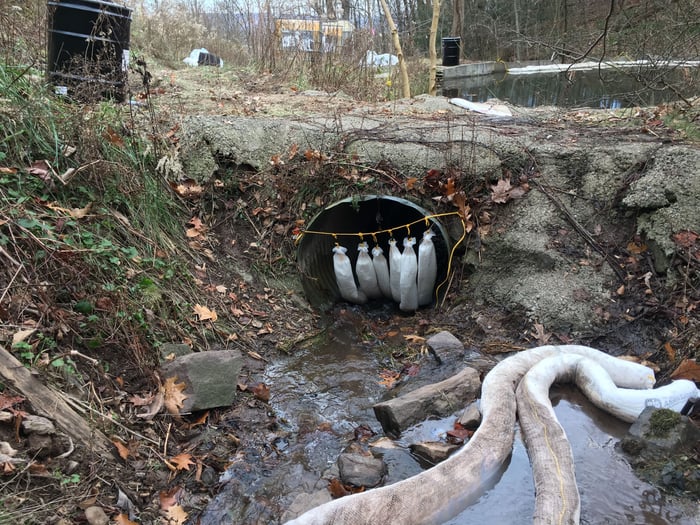You've seen the problem thousands of times before. Oil gets into a stream or river and spreads downstream in the blink of an eye.
Traditional wisdom dictates you should block the spill with a containment boom as quicly as possible. Makes sense.
But in smaller, rocky streams containment booms don't work. There is just not enough water to float the boom.
In most cases, responders place floating sorbent booms and socks across the stream in an effort to slow the progress of the spill. In some cases, this can help if the stream deep enough and flowing slowly.
But in faster, shallow water, sorbent booms tend to "bob" up and down (allowing the oil to flow over top the sock).
One day last summer our dear friend, Tim Acri, was showing us how to angle the floating sorbent socks slightly downstream to "steer" the spill to a collection point where we could vacuum or absorb the remaining product. It was a brilliant technique and worked like a charm.
Later in the autumn we were called to relatively large heating oil spill on the headwaters of a rugged mountain trout stream. When we arrived, the contractor had already installed multiple sorbent booms across the rocky creek.
Unfotunately, much of the oil was floating over and around the booms because of the irregular rocky stream bed and banks. As you can see in the photo below, the white booms running perpendicular to the stream show the signs of oil "over-topping" them and continuing downstream.
So, we decided to test a new idea by tying together a "stringer" of our flexible SpillBoa flat booms and installing them at a culvert inlet.
The idea was to put as much surface area of the SpillBoa booms in touch with the floating oil. Rather than fight the current, we decided to go with the flow.
As you can see from the photo below, the stringer of SpillBoas are covering the entire surface of the water entering the inlet side of the culvert. And, they have enough leeway to rise and fall during rain events. This keeps the SpillBoas on the surface, in contact with the oil.

When we came back the next day, the Spillboas were completely saturated with fuel oil. Notice the "orangeish" color of the SpillBoas on the downstream side at the culver outfall.
In fact the SpillBoas that "went with the flow" caught so much oil that the floating booms downstream remained white...indicating that the vast majority of the oil was captured before it arrived.
.jpg?width=640&name=Saturated%20stringer%20of%20SpillBoas%20at%20culvert%20outlet%20(4).jpg)
The moral of the story? Sometimes it's best to go with the flow.
Topics: Spill Cleanup, "oil spills on water"